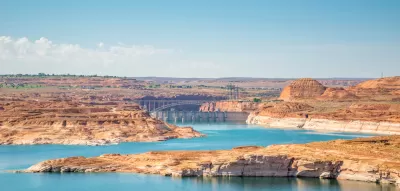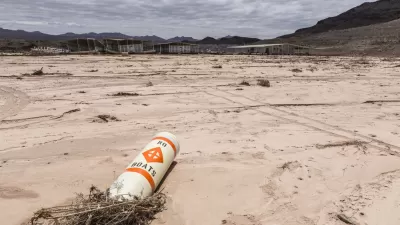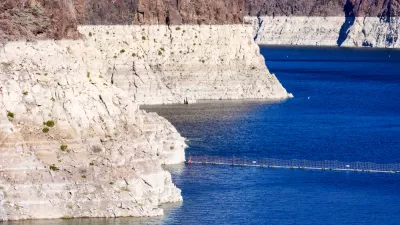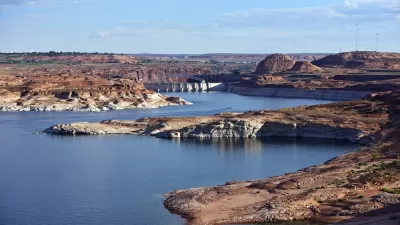Officials are releasing water from upstream reservoirs as water levels in the river's major reservoirs fall to historic lows.

As a historic drought continues into its third decade, the hydroelectric dams along the Colorado River will start seeing less electricity production, potentially causing electricity costs to rise across the West, writes Luke Runyon. "Lake Powell is the nation’s second largest reservoir," producing power for 5 million people. "Later in July it’s projected to hit its lowest point since it first filled in the 1960s, set to drop below its previous low set in 2005." If water levels continue to drop, "[h]ydropower production might become unfeasible at elevations above 3,490 feet due to turbine cavitation, when small air bubbles form and cause damage to the machine’s inner workings."
"The declining water levels have sent those who market and distribute Colorado River basin hydropower to their customers to figure out how to make up the energy deficit." Clayton Palmer with the Western Area Power Administration, which distributes power produced at Glen Canyon Dam, "said this year his agency will have to purchase millions of dollars in extra electrical power on the open market to fulfill their contracts."
On July 19, "[f]ederal officials laid out details of how reservoirs upstream of Lake Powell will release water in an attempt to keep producing hydropower," but the planned releases from upstream reservoirs amount to a short-term fix. "There comes a point where we can't engineer our way out of this," said Christopher Cutler, water and power services manager for the Bureau of Reclamation. "If the basin’s dry conditions continue into 2022, the situation could become more dire."
FULL STORY: Hydropower Worries Grow As Colorado River Reservoirs Keep Dropping

Alabama: Trump Terminates Settlements for Black Communities Harmed By Raw Sewage
Trump deemed the landmark civil rights agreement “illegal DEI and environmental justice policy.”

Study: Maui’s Plan to Convert Vacation Rentals to Long-Term Housing Could Cause Nearly $1 Billion Economic Loss
The plan would reduce visitor accommodation by 25% resulting in 1,900 jobs lost.

Planetizen Federal Action Tracker
A weekly monitor of how Trump’s orders and actions are impacting planners and planning in America.

Wind Energy on the Rise Despite Federal Policy Reversal
The Trump administration is revoking federal support for renewable energy, but demand for new projects continues unabated.

Passengers Flock to Caltrain After Electrification
The new electric trains are running faster and more reliably, leading to strong ridership growth on the Bay Area rail system.

Texas Churches Rally Behind ‘Yes in God’s Back Yard’ Legislation
Religious leaders want the state to reduce zoning regulations to streamline leasing church-owned land to housing developers.
Urban Design for Planners 1: Software Tools
This six-course series explores essential urban design concepts using open source software and equips planners with the tools they need to participate fully in the urban design process.
Planning for Universal Design
Learn the tools for implementing Universal Design in planning regulations.
Caltrans
Smith Gee Studio
Institute for Housing and Urban Development Studies (IHS)
City of Grandview
Harvard GSD Executive Education
Toledo-Lucas County Plan Commissions
Salt Lake City
NYU Wagner Graduate School of Public Service





























